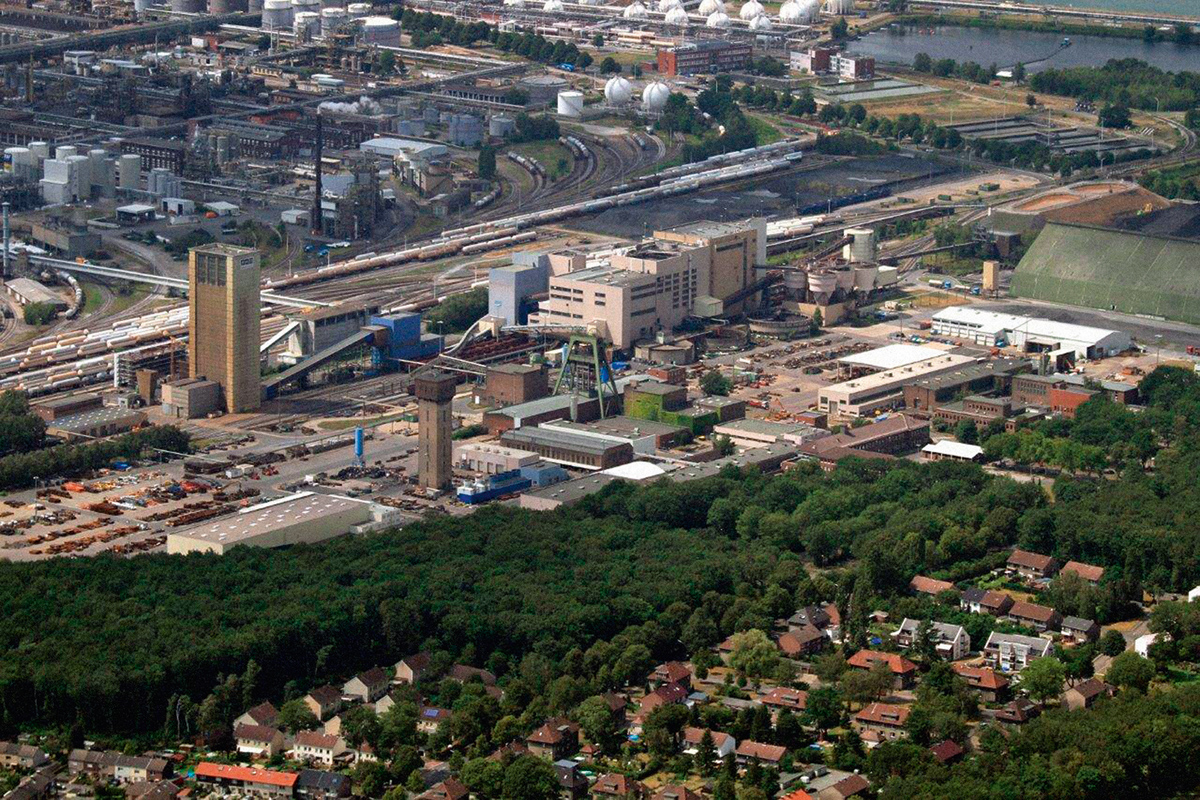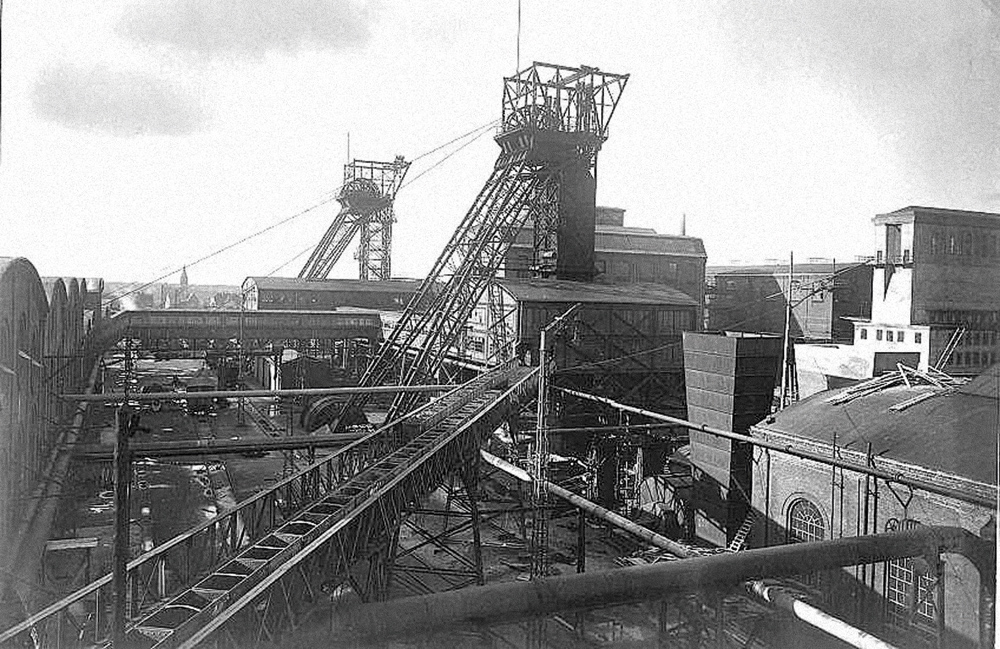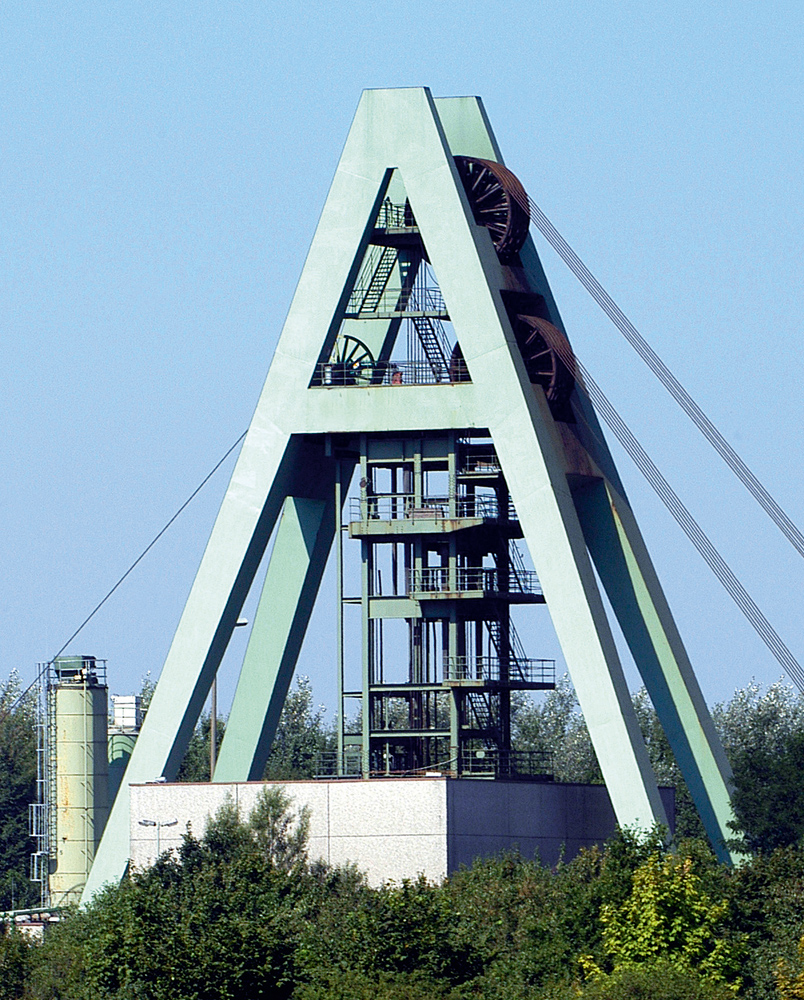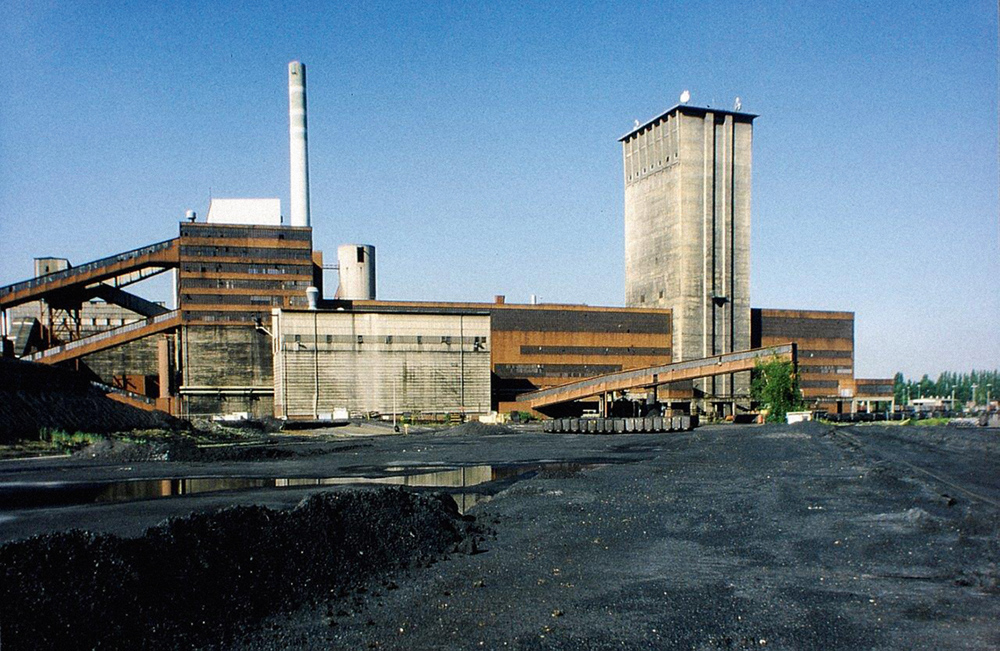Dipl.-Ing. Jürgen Kroker,
Leiter des Bergwerks Auguste Victoria der RAG Aktiengesellschaft, Marl
Introduction
Auguste Victoria colliery in Marl (Figure 1) will stop producing coal on 31th December 2015, spelling the end of 110 years of mining in the area around Marl where coal was first dug in 1905. The colliery owes its name to the wife of the last German Kaiser, Wilhelm II, whose popularity and reputation made her a much sought-after patron. The Auguste Victoria Association, which first ran the mine, was set up in 1898 by the Dusseldorf businessman and commercial advisor August Stein and the Dusseldorf-based engineer Julius Schäfer.

Fig. 1. Colliery facility AV 3/7 of Auguste Victoria colliery // Bild 1. Schachtanlage AV 3/7 des Bergwerks Auguste Victoria. Photo/Foto: RAG
In 1906 the 519-strong workforce mined 46,699 t of coal, while in its final year the colliery will produce about 2.1 m t with a workforce of 2,000, of which 700 will be transferred to other mines after Auguste Victoria closes. A team of around 450 will be retained on site in 2016 to carry out salvage and dismantling work, while the rest of the workforce will be relocated or will take early retirement.
110 years of mining in Marl – how it all began
As many as 20 different drilling companies were already competing for coal in the Marl area by the 1870s. In September 1896 August Stein and Julius Schäfer began drilling boreholes in the Sinsen area and in the following year they struck it lucky. They then applied for a licence for the Hansi I and II mining claims, which were subsequently consolidated in November 1898 to create the Auguste Victoria concession. The acquisition of further areas meant that by 1907 the rights to the Auguste Victoria take covered an area of 23.454 km2 and extended as far as the river Lippe. According to the colliery surveyors the permit area contained up to 380 m t of coal.
Right from day one all kinds of technical innovations were tested and employed at the colliery. This began with the sinking of the first mine shafts. On 14th October 1899 the mine’s board of directors took the decision to ‘construct a twin-shaft colliery with two double shafts’ to be located about 5 km north-east of the village of Marl, in an area now known as Hüls. The sinking operation for shafts number 1 and 2, which were to be 6.7 m and 9 m in diameter respectively, was positioned on the Zweckel-AV anticline and used the caisson construction method that had already been well tried in the Ruhr coalfield. Water subsequently broke into the sinkings in September 1901 and the operation had to be temporarily suspended before the decision was taken to continue with number 2 shaft (which was renamed number 1 shaft) using the freezing method. The original number 1 shaft sinking was therefore abandoned. Never before in the history of Ruhr mining had the freezing technique been attempted in such a thick zone of running sand as was encountered at Auguste Victoria. Drilling re-commenced in number 1 shaft in February 1902 and in early 1904 work also began on the sinking of a new number 2 shaft, some 80 m away from the location of number 1 (Figure 2). A coke oven battery was also built and the first batch of coke was produced at the AV 1/2 site in 1908.

Fig. 2. Historical view on the colliery facility AV 1/2 of Auguste Victoria colliery. // Bild 2. Schächte 1 und 2 des Bergwerks Auguste Victoria
in historischer Aufnahme. Photo/Foto: RAG
By the mid-1920s the Auguste Victoria mining concession extended across the townships of Hüls (Recklinghausen-Land), Marl and Hamm. While mining facility 1/2 was built in Hüls, the proposed shaft facility 3/4 was located in Marl and the colliery-owned docks were established in the Hamm-Bossendorf area. It was here too that the third shaft facility would be built. This meant that Auguste Victoria was subject to taxation in different local authority districts. The management responded to this drawback by ensuring that the colliery operations at least were concentrated at a single site, namely the municipality of Marl-Hüls.
In 1925 Paul Stein, the son of August Stein and until 1939 the first director of the Auguste Victoria Association, pleaded for the formation of ‘a new municipal district consisting of the townships of Marl, Drewer, Hüls, Löntrop, Lenkerbeck and Sinsen […]. This would create a large and productive community with two large taxpaying entities’, namely Auguste Victoria and Brassert collieries (1). In line with the wishes expressed by the Auguste Victoria Association the rural community of Recklinghausen was dissolved on 26th February 1926 and replaced by the municipal district of Marl, comprising the townships of Hüls, Lenkerbeck and Löntrop, the rural community of Oer and the western part of Sinsen. The new district of Marl covered some 111 km2 and had a population of nearly 34,500 (2, 3). It also came into possession of the Sinsen railway station and the extensive woodlands of the Haard. Marl went on to receive its town charter just ten years later, on 12 April 1936.
Colliery takeover – from autonomy to integration
In 1904 the ‘Dreibund’ of BASF (Ludwigshafen), Bayer (Elberfeld) and Agfa (Treptow-Berlin) came together to form a community of interests, though each continued to remain legally independent. By 1907 this group was in charge of Auguste Victoria colliery. Thirty years later I.G. Farbenindustrie AG took over the Auguste Victoria Association. Under the terms of the Control Council Act I.G. Farben was broken up in 1945 and the colliery was requisitioned and placed under the control of the Allies. The newly-established BASF AG again took possession of Auguste Victoria in 1953.
On 27th March 1991 the representatives of Ruhrkohle AG and BASF AG signed a takeover agreement with retroactive effect from January of that same year. Auguste Victoria was henceforth commercially part of Ruhrkohle AG, though legally remained an independent entity. On 1st January 1996 the Auguste Victoria Association, which under the provisions of the Federal Mining Act (BBergG) of 5th November 1993 had been converted into a limited liability company (though was allowed to retain the word ‘Association’ in its name), was finally incorporated into Ruhrkohle AG.
The story continues – technical development and colliery expansion
In 1922 the Auguste Victoria Association again took up the plan to sink the twin-shaft facility 3/4 in the northern part of the take. However, because of inflation, and the fact that the Ruhr was still an occupied area, the freeze-hole drilling required for this undertaking could not be resumed until 1925. In December 1926 AV3 shaft reached its final depth of 820 m, though then suffered a collapse the following year, just before its commissioning, due to a fracture of the tubbing column. Sinking resumed in 1934 and the shaft was finally completed one year later.
An extension of the underground power supply to include compressed air and electricity led to the introduction of jackhammers and compressed-air picks at the coal face. While there were just 264 jackhammers operating in the Ruhr coalfield in 1913, this had increased to nearly 45,000 by 1925. By the year 1930 more than 78,000 were in use below ground (4, 5) and the percentage of coal being extracted in this way rose accordingly, from 2.2 % in 1913 to 92.2 % in 1930 (6). Coal cutting machines were first introduced in the northern part of the Ruhr coalfield, where the medium- and high-volatile bituminous coal beds meant working in harder seams than in the southern Ruhr districts. Auguste Victoria first began using arm coal-cutters and chain coal-cutters for level-seam faces in 1924 (7), though the ultimate breakthrough for the coal shearer and coal plough did not come until after the Second World War. By 1925 there were six large coal-cutting machines and 299 jackhammers in operation at Auguste Victoria.
Auguste Victoria is one of the few pits in the Ruhr coalfield where ore was once mined along with the coal. The AV 4/5 twin-shaft facility that commenced operation in 1931 was also used for ore miners, which is why it is also known as the ‘ore shaft’. However the ore was actually wound to the surface via the AV 1/2 shafts. Falling lead and zinc prices then meant that ore mining was no longer profitable and ore extraction came to an end in 1962.
More shafts were to follow: in 1950 work started on number 6 shaft, which was to serve as a ventilation shaft for AV 1/2 and 3. Then in 1957 sinking work began on the new winding and ventilation shaft AV 7, which was positioned close to number 3 shaft. This new shaft would greatly improve the underground ventilation, including that of AV 1/2, and would in addition help raise the coal winding capacity. In 1963 the coke works was closed and three years later winding operations ceased at the AV 1/2 and AV 4/5 shaft installations. Work also started on the sinking of the new AV 8 ventilation shaft in Haltern-Lippramsdorf (Figure 3).
The 1950s saw the development of different coal shearing machines fitted with pick-laced cutting heads and drums. During the period 1948 to 1953 alone there was a five-fold increase in the number of cutting winning machines in operation (8, 9). The drum shearer-loader, a combined coal winning and loading machine, was introduced into the Ruhr coalfield in 1956 and first saw service at Auguste Victoria colliery in 1958 (10, 11). The new drum shearer, followed by the double-drum shearer that was introduced in 1961, meant that by 1965 the old coal cutting machines had been entirely superseded by fully-mechanised cutting winning installations (12). By the end of the 1950s the jackhammers that in 1951 had been responsible for nearly 73 % of all the coal being mined in the Ruhr coalfield were for the most part replaced by new, mechanised winning methods (13). During the 1960s coal winning in the Ruhr, and at Auguste Victoria too, was to a large extent a fully-mechanised process and, according to colliery management figures, by 1 April 1964 jackhammers were no longer being used for coal winning, even in the AV 1/2 workings.
The year 1977 also saw Auguste Victoria introduce diesel trolleys on the overhead monorail installations that were used for materials transport and manriding operations (14). One unusual installation in service at this time was the 300-seat chair lift system that operated in the eastern incline of district 5 at Auguste Victoria (15). This was used to transport the district’s 450-strong workforce over a distance of some 780 m.
The development drivages at Auguste Victoria were now mainly progressing in a northerly direction towards the as-yet undeveloped Lippramsdorf area where the colliery’s future would lie. The Voest-Alpine AM 75 roadheading machine was employed for the first time in the colliery’s western districts, where it was operated by a team from Thyssen Schachtbau GmbH.
The AV 8 shaft was converted for manwinding operations and these commenced in 1982. Number 9 shaft was sunk in the Hohe Mark area and went into service in 1990 as a ventilation shaft serving the northern working districts.
On 19 October 1999 the Deutsche Steinkohle AG (DSK) management board took the decision to merge Blumenthal/Haard in Recklinghausen and Oer-Erkenschwick (Figure 4) with Auguste Victoria to create a combined mine. The connecting roadway required for this merger broke through in November 2001. In 2003 a general operating plan was agreed that gave approval for the mine to continue coal production until 31 December 2015.
Additional investment was required in order to ensure that the underground equipment, including roadheading machines, coal winning installations and transport and conveying systems, was kept up-to-date with the latest developments. One recent example of this has been the introduction of the Eickhoff SL 750 drum shearer, a machine that has ‘now essentially been adopted as standard technology’ (16). This coal shearer – weighing-in at 78 t minus its cutting drums – was designed for operation in seams of 2.4 m to 4.0 m. The latest version of the SL 750, which comes equipped with EiControlPlus technology, is fully automatic and has infrared sensors that can distinguish between coal and seam dirt (17).

Fig. 5. Wind turbines on the Brinkfortsheide spoil tip. // Bild 5. Windenergieanlagen auf der Halde Brinkfortsheide. Photo/Foto: RAG
One of the most significant investments in the colliery surface installations was made in 2004 with the construction of a modern central stores facility at AV 3/7 that was designed to serve all the mines in the RAG group.
In July 2014 work began on the construction of the first two of three wind turbines on the Brinkfortsheide spoil tip in Marl (Figure 5). The two turbine units will in future be capable of supplying around 5,300 three-person households each consuming 3,500 kW of electricity a year (18). After the dirt filling operation has terminated on the old tip and tip extension, and the area has been re-planted and hiking paths laid through it, the former colliery tip is to be opened to the public as a new landscape project (19).
Looking ahead – structural change in Marl
The town of Marl is faced with the challenge of finding a new perspective for the post-mining era. While the Marl Chemical Park continues to offer significant employment opportunities, the local job market is limited in its capacity. With the decline of the mining industry Marl will be losing one of the region’s most important training providers. The closure of the colliery will also leave behind a gap in the local cultural scene. And Marl does not have the financial resources needed to forge ahead with structural change of its own accord.
‘We can already point to some good results when it comes to the development of former mining sites in the Ruhr area’, according to Garrelt Duin, Minister Economic Affairs, Energy, Trade and Industry, speaking at the EXPO REAL 2014 real estate fair in Munich. He went on: ‘After the signing of the ‘Change as an opportunity’ agreement in February the region has been funding an initial feasibility study for the Auguste Victoria site in Marl. Working closely with the town of Marl, RAG and RAG Montan Immobilien the potential for commercial and industrial development is now to be examined with the focus on logistics services’. The ‘Change as an opportunity’ agreement was signed in February 2014 at the Ewald Future Site in Herten and involved the Land Government of North Rhine-Westphalia, 21 municipalities and local districts, RAG Aktiengesellschaft, the RVR (Ruhr Regional Association) and RAG Montan Immobilien GmbH. The signatories pledged to be part of a proactive revitalisation of some 20 former coal industry sites in North Rhine-Westphalia. While it was coal that first attracted the chemical industry to Marl in the early part of the 19th century, it will for the foreseeable future be chemicals alone that will have to act as the economic flagship of the town.
References / Quellenverzeichnis
References / Quellenverzeichnis
(1) montan.dok/BBA 257/2246, Memorandum Stein: Zuteilung der Ortschaften Hüls, Lenkerbeck und Löntrop aus der Landgemeinde Recklinghausen zur Gemeinde Marl, 10. Oktober 1925, S. 2.
(2) Vgl. Neubauer, Christoph, Marl, in: Heineberg, Heinz/Mayr, Alois/Seidel, Wolfgang/Temlitz, Klaus (Hg.): Städte und Gemeinden in Westfalen. Die Emscher-Lippe-Region. Der Kreis Recklinghausen, die Stadt Bottrop, die Stadt Gelsenkirchen, Münster 2002, S. 183 – 199, hier S. 186.
(3) Schäpers, Heinrich: Bilder aus der Geschichte Marls, Marl 1966, S. 80.
(4) Vgl. Burghardt, Uwe: Die Mechanisierung des Ruhrbergbaus 1890 – 1930, S. 392.
(5) Spethmann, Hans: Das Ruhrgebiet, Bd. 3, S. 728.
(6) Vgl. Tenfelde, Klaus: Der bergmännische Arbeitsplatz während der Hochindustrialisierung (1890 – 1914), S. 312.
(7) LAV NRW W, B 184 Re 2/10556, Betriebsplan AV für das Jahr 1925, 15. Dezember 1924, S. 10.
(8) Farrenkopf, Michael: Wiederaufstieg und Niedergang des Bergbaus in der Bundesrepublik. In: Geschichte des deutschen Bergbaus, Bd. 4, S. 210.
(9) Kost, Heinrich: Die Tätigkeit der Deutschen Kohlenbergbauleitung. In: Sonderabdruck aus Glückauf 90 (1954), S. 2.
(10) montan.dok/BBA 257/11, Entwicklung der Schrämarbeit auf der Schachtanlage 3/7-6, 7. Februar 1960, S. 2.
(11) montan.dok/BBA 257/11, Schachtanlage 3/7, Gewerkschaft AV, März 1961, S. 9.
(12) Kroker, Evelyn: Der Arbeitsplatz des Bergmanns, Bd. 2, S. 167.
(13) Rauer, Gerhard: Die Bemühungen des westdeutschen Steinkohlenbergbaus um die Mechanisierung der Kohlengewinnung, in: Glückauf 49/50 (1953), S. 1212.
(14) Vgl. Farrenkopf, Michael u. a. (Hg.): Glück auf! Ruhrgebiet. Der Steinkohlenbergbau nach 1945, S. 398. Erste Probeeinsätze wurden mit Dieselkatzen schon 1967 unternommen. Zehn Jahre später standen im nordrhein-westfälischen Bergbau 170 Dieselkatzen mit einem Streckennetz von circa 225 km in Betrieb. Vgl. Hoischen, Gerhard/Hackenberg, Werner: Sicherer Fahrbetrieb mit Dieselkatzen im Steinkohlenbergbau Nordrhein-Westfalens, in: Glückauf 2 (1977), S. 64.
(15) N.N.: Im Ostberg denkt man an den Kahlen Asten, in: AV Information 3 (1979), S. 9.
(16) N.N.: Bauhöhe 591 angelaufen, in: AV Aktuell 12 (5. Oktober 2010).
(17) Vgl. Nienhaus, Karl/Mavroudis, Fiona: Automatisierung und Prozessüberwachung im Bergbau mittels Infrarotsensorik und industrieller Bildverarbeitung. In: Glückauf 4 (2009), S. 168 – 172.
(18) N.N.: Volle Windkraft voraus. Windprojekt Brinkfortsheide. In: Schachtecho 75 (Dezember 2014), S. 15.
(19) N.N.: Bergehalde und Landschaftsbauwerk. Der Tagesbetrieb entwickelt Brinkfortsheide zu einem Naherholungsgebiet. In: Steinkohle 8 (2012), S. 18.
Dipl.-Ing. Jürgen Kroker,
Leiter des Bergwerks Auguste Victoria der RAG Aktiengesellschaft, Marl

